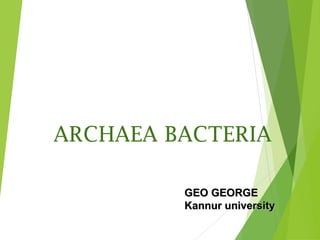Archaea are a domain of single-celled microorganisms first proposed by Carl Woese in the 1970s based on rRNA sequencing. They include methanogens, extremophiles that thrive in hot, salty, or acidic environments. Archaea have unique cell structures and metabolisms that differ from bacteria and eukaryotes, such as ether-linked lipids in their cell membranes and use of novel coenzymes in methanogenesis. While challenging to culture and study, archaea play important roles in carbon and nutrient cycling in diverse ecosystems.






![Property Archaea Bacteria Eukarya
Cell Membrane Ether-linked lipids,
pseudopeptidoglycan
Ester-linked lipids,
peptidoglycan
Ester-linked lipids, various
structures
Gene Structure
Circular chromosomes,
similar translation and
transcription to Eukarya
Circular chromosomes,
unique translation and
transcription
Multiple, linear
chromosomes, similar
translation and
transcription to Archaea
Internal Cell Structure No membrane-bound
organelles or nucleus
No membrane-bound
organelles or nucleus
Membrane-bound
organelles and nucleus
Metabolism[45]
Various, with
methanogenesis
unique to Archaea
Various, including
photosynthesis, aerobic
and anaerobic respiration,
fermentation, and
autotrophy
Photosynthesis and
cellular respiration
Reproduction Asexual reproduction,
horizontal gene transfer
Asexual reproduction,
horizontal gene transfer
Sexual and asexual
reproduction
Comparison to other domains](https://image.slidesharecdn.com/ggarchea-141120054645-conversion-gate01/85/archea-7-320.jpg)


![ Physiology
Aerobic, facultative and strictly anaerobic
Range from chemolithotrophs to organotrophs
Mesophilic & hyperthermophiles
Found in extreme environments
Few are symbionts in animal digestive system
eg- the marine archaean Cenarchaeum symbiosum lives
within (is an endosymbiont of) the sponge
Axinella mexicana.[180]
CCoonnttdd……](https://image.slidesharecdn.com/ggarchea-141120054645-conversion-gate01/85/archea-10-320.jpg)










![ Genomes are significantly smaller than bacteria.
E. coli – 2.5 x 109 Daltons
T. acidophilum – 0.8 x 109 Daltons
Methanosarcina acetivorans,[116] the largest known
archaeal genome.
Nanoarchaeum equitans, the smallest archaeal genome
known;
plasmids are also found
Archaea usually have a single circular chromosome](https://image.slidesharecdn.com/ggarchea-141120054645-conversion-gate01/85/archea-21-320.jpg)






































